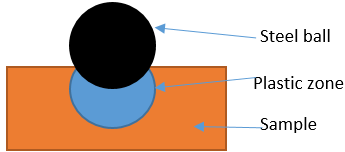This set of Mechanical Metallurgy Multiple Choice Questions & Answers (MCQs) focuses on “Tension Test – Brinell Hardness”.
1. The Meyer’s hardness measurement is based on the principle of ____________
a) surface area
b) projected area
c) depth of indentation
d) unrecovered area
View Answer
Explanation: Mayer’s suggested the concept of hardness measurement based on the projected area of the impression rather than the surface area.
2. The mean pressure between the surface area of the indenter and indentation in Meyer’s hardness measurement is given by P/πr2 where P is applied load r is the radius of the surface area.
a) True
b) False
View Answer
Explanation: Meyer’s hardness is measured by the mean pressure of the intendant.
Mayer’s hardness number is given as:
\(\frac{4P}{πd^2}\)
3. The unit of Meyer’s hardness measurement is _________
a) kg
b) kg/mm2
c) kg-mm
d) Unit less
View Answer
Explanation: The Mayer’s hardness number is given is by :
\(\frac{4P}{πd^2}\)
The unit of P is kg and d is measured in mm, so the final unit will become Kg/mm2
4. The Meyer’s hardness is more sensitive to applied load than the Brinell hardness test.
a) True
b) False
View Answer
Explanation: Meyer’s hardness measurement is less susceptible to applied pressure than Brinell hardness measurement.
5. For an annealed metal, the Meyer’s hardness ___________ with increasing load.
a) increases
b) decreases
c) remains constant
d) depends upon the material
View Answer
Explanation: The hardness value increases by increasing the load, which produces the strain hardening in the material, so the required stress value for deformation increases.
6. The following diagram shows the distribution of plastic zone (blue colored region) beneath the indenter during the Brinell hardness test.

a) True
b) False
View Answer
Explanation: Below the plastic zone is the rigid elastic zone, and hardness measurement in real sense is the measurement of indentation in the local area where plastic deformation occurs.
Sanfoundry Global Education & Learning Series – Mechanical Metallurgy.
To practice all areas of Mechanical Metallurgy, here is complete set of 1000+ Multiple Choice Questions and Answers.
If you find a mistake in question / option / answer, kindly take a screenshot and email to [email protected]
- Check Mechanical Metallurgy Books
- Check Metallurgical Engineering Books
- Practice Metallurgical Engineering MCQs
- Apply for Metallurgical Engineering Internship
